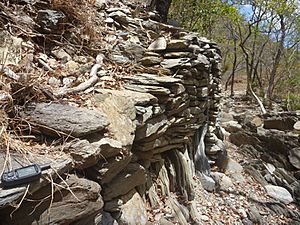Nuggety Gully Water Race and Chinese Camp facts for kids
Quick facts for kids Nuggety Gully Water Race and Chinese Camp |
|
|---|---|

Stone retaining walls at Nuggety Gully, 2014 (mobile phone in lower left for scale)
|
|
| Location | Mareeba Mining District, Lakeland, Shire of Cook, Queensland, Australia |
| Design period | 1870s - 1890s (late 19th century) |
| Built | c. 1878 - c. 1886 |
| Official name: Nuggety Gully Water Race and Chinese Camp, Greasy Bill Creek water race, Prospect Creek Stone Walls, Star of Normanby Mine | |
| Type | state heritage (built, archaeological) |
| Designated | 21 October 1992 |
| Reference no. | 600426 |
| Significant period | c. 1878-c. 1886 (fabric) |
| Significant components | terracing, shaft, water race, fireplace, mine - open cut, wall/s - retaining |
| Lua error in Module:Location_map at line 420: attempt to index field 'wikibase' (a nil value). | |
Nuggety Gully Water Race and Chinese Camp is a special historical place in Queensland, Australia. It's located near Lakeland in the Mareeba Mining District. This site includes old water channels and a camp where Chinese gold miners lived and worked.
The site was built between about 1878 and 1886. It is also known by other names like Greasy Bill Creek water race, Prospect Creek Stone Walls, and Star of Normanby Mine. Because of its historical importance, it was added to the Queensland Heritage Register on October 21, 1992.
History of Gold Mining
Gold Discovery in Queensland
Gold was first officially found in the West Normanby River area in November 1874. This area is southwest of Cooktown. By early 1875, over 600 miners had arrived, many from Maytown.
Chinese Miners Arrive
At first, Chinese miners were not allowed into the goldfields. However, by February 1878, at least 200 Chinese miners were working there. They mostly focused on finding gold in riverbeds, which is called alluvial gold.
Life at the Diggings
In May 1886, an official named Howard Saint George visited the mining area. He reported that 34 European miners were working on gold found in rock veins, called reefs. He also noted that thirty to forty Chinese miners were working on alluvial gold.
The Chinese miners also grew crops like maize (corn) in gardens. They sold these crops to other miners, which was a good business.
When the Camp Was Built
A government geologist named R. L. Jack visited the area in 1898. By then, most of the gold diggings had been left. His maps showed Chinese camps in the wider area, but not specifically at Nuggety Gully. This suggests that the stone walls and terraced camp site at Nuggety Gully were built earlier. They were likely constructed between 1878, when mining was busy, and 1886.
What Nuggety Gully Looks Like
Nuggety Gully is a deep, rocky valley. It has a dry streambed that flows into Prospect Creek.
Stone Walls and Water Channels
The site has many stone walls built by hand. These walls stretch along Nuggety Gully for about 600 meters (about 2,000 feet) north of Prospect Creek. Most of these walls are on the western side of the gully. In some places, they are on both sides and built in two or more levels.
The narrowest parts of the creek between these walls are about 2 meters (6.5 feet) wide. The walls themselves are usually 1 to 2 meters (3 to 6.5 feet) tall. These walls were likely built to control water flow for mining or to create flat areas for living.
Star of Normanby Mine
About 300 meters (about 1,000 feet) north of Prospect Creek, you can find the old Star of Normanby gold mine. This includes a small open pit and a caved-in mine shaft. These mine workings are directly connected to the stone walls.
Chinese Camp Site
A Chinese settlement site is located where Prospect Creek meets Nuggety Gully. This site has nine small flat areas, or terraces, dug into the ground. Some of these terraces have stone edges. Two of them even have old fireplaces.
One larger stone fireplace or oven has been partly rebuilt recently. It's important to know that this structure was once incorrectly described as a "fort" where Chinese miners hid from Aboriginal people. This description is not true.
Why This Place Is Important
Nuggety Gully Water Race and Chinese Camp is listed on the Queensland Heritage Register for several reasons:
Showing Queensland's History
This site is very important because it shows how Queensland's history developed. The stone walls and Chinese camp are the best and largest examples of Chinese stonework from that time.
Unique Cultural Heritage
It's rare to find stone walls, Chinese camp sites, and mine workings all together in one place. This makes Nuggety Gully a very special and uncommon historical site.
Learning from the Past
This place has the potential to teach us more about Queensland's history. By studying the site and old records, we could learn a lot about what Chinese miners did and how they were involved in the Star of Normanby mine area.
Great Example of Mining Sites
The quality of the stonework at Nuggety Gully is excellent. It has stayed in good condition because the area is rough and hard to reach by vehicles. This has stopped people from trying to mine there again and damaging the old structures.

